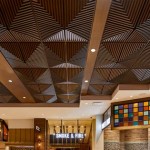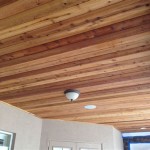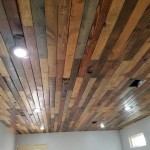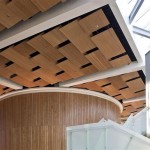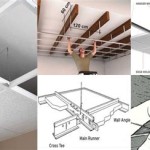How to Install PVC Wall Panels on a Ceiling
PVC wall panels, known for their durability, moisture resistance, and ease of installation, are becoming increasingly popular for both interior and exterior applications. While typically used on walls, PVC panels can also be effectively installed on ceilings, offering a stylish and practical alternative to traditional materials like drywall or plaster. This guide will provide a comprehensive step-by-step process on how to install PVC wall panels on a ceiling, ensuring a successful and visually appealing outcome.
Preparing the Ceiling
Before commencing the installation, thorough preparation of the ceiling surface is crucial. This involves removing any existing materials, such as drywall, plaster, or wallpaper, ensuring a clean and level surface for panel attachment. Any cracks or unevenness should be filled with spackle and allowed to dry completely. It's also essential to remove any dust, dirt, or debris from the surface to promote adhesion. If the ceiling is painted, a light sanding may be necessary to enhance the bond with the panels.
Next, you need to determine the layout of the PVC panels. Measure the ceiling’s length and width to calculate the required number of panels. It's advisable to plan the installation to minimize waste and ensure a seamless aesthetic. Consider the panel's width and the ceiling's dimensions to determine the best starting point and the arrangement of panels.
For added security and stability, consider installing furring strips on the ceiling. These strips, typically made of wood or metal, provide a solid base for attaching the PVC panels. Furring strips are particularly useful for uneven ceilings or if the panels are being installed over an existing surface. This step involves securing the strips to the ceiling with screws or nails at consistent intervals, ensuring the strips are level and parallel to each other.
Installing PVC Wall Panels on the Ceiling
With the ceiling prepared, you can now proceed with the installation of the PVC wall panels. Start by attaching the first panel at the chosen starting point. Using a level, ensure the panel is perfectly aligned and secured to the ceiling with construction adhesive or panel clips. Apply the adhesive liberally across the back of the panel and press it firmly against the ceiling, holding it in place for a few moments to ensure a strong bond.
For panel clips, follow the manufacturer's instructions to install the clips along the ceiling’s perimeter and at any necessary points for support. The clips are designed to securely hold the panels without the use of adhesive. After attaching the first panel, the subsequent panels will be installed in a similar manner, ensuring they are tightly butted against each other to create a seamless finish.
When cutting panels to size, use a sharp utility knife or a specialized PVC cutting tool for precise cuts. Measure the required length and score the panel with the cutting tool, applying gentle pressure along the scored line to snap the panel. After the first row of panels is installed, proceed with the next row, ensuring the panels are properly aligned and butted against the previous row. If necessary, use a trim piece or a decorative molding to conceal any gaps at the perimeter of the ceiling.
Final Touches and Finishing
Once all the PVC panels are installed, inspect for any gaps or imperfections. Use a caulking gun and a suitable sealant to fill any gaps between panels, ensuring a smooth and watertight finish. Allow the sealant to dry completely before proceeding with the next step.
The final step involves applying a finishing touch to the PVC panels. Paint them with a suitable paint chosen to complement the room's décor. Alternatively, you can apply a sealant or a protective coating to enhance the panels' durability and preserve their appearance. The final step is crucial in achieving a professional-looking finish and maximizing the longevity of the installed ceiling.
Key Points for Successful PVC Ceiling Installation
1. Measuring and Cutting Accuracy
Precise measurements and accurate cutting are key to achieving a seamless and professional-looking finish. Carefully measure the ceiling and each panel before cutting. Use a straight edge and a sharp utility knife or a specialized tool for PVC cutting for precise cuts. Ensure that all cuts are at a 90-degree angle to maintain a consistent appearance.
2. Panel Alignment and Butting
Maintaining alignment and butting the panels tightly together is essential for a visually appealing ceiling. Use a level to ensure that each panel is perfectly aligned and secured to the ceiling. Ensure that the panels are butted tightly against each other to avoid any gaps or misalignments.
3. Proper Sealing and Finishing
Sealant and finishing touches play a vital role in enhancing the ceiling's durability and aesthetics. Use a suitable sealant to fill any gaps between panels, ensuring a smooth and watertight finish. Consider painting the panels or applying a protective coating to complement the room's décor and protect the PVC panels from UV rays and other elements.

How To Install Ceiling Panels The Panel Company

Installing Wall And Ceiling Panels In Your Kitchen Or Bathroom

7 Ways To Fit Plastic Ceiling Panels Wikihow

Pvc Ceiling Panels Cladding Installation

How To Install A Pvc Ceiling Cladding Guide

How To Install Pvc Panel In Ceiling Design And

7 Ways To Fit Plastic Ceiling Panels Wikihow

How To Install Pvc Panels On Top Of Any Surface Structural Inc

Can You Use Wall Panels On The Ceiling Dbs Bathrooms

Vox Wall Panels Ceiling Installation Pvc Wpc
Related Posts

